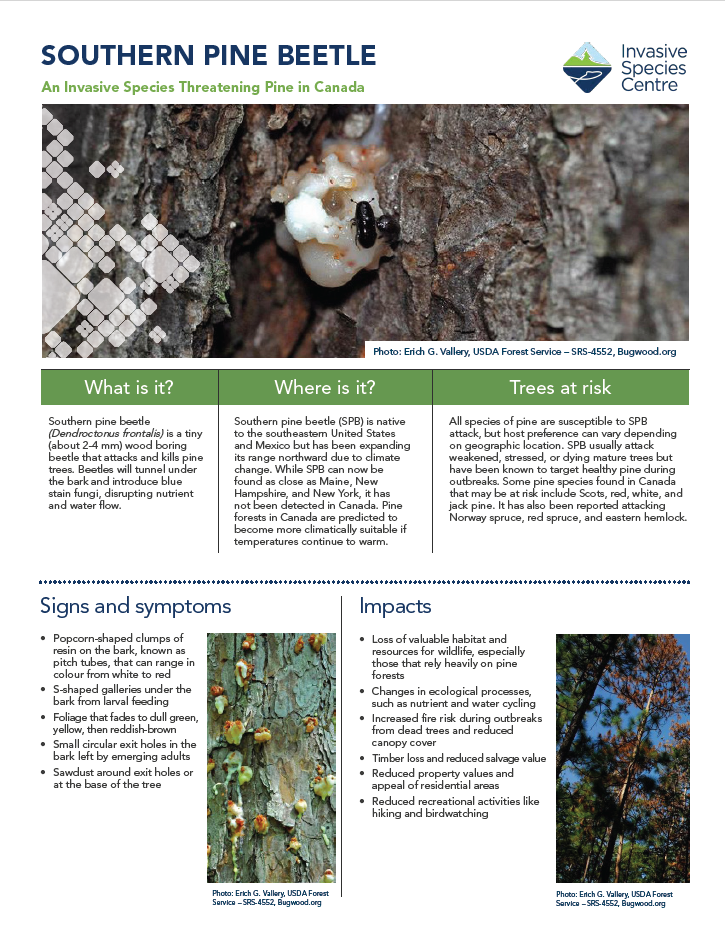Southern Pine Beetle (Dendroctonus frontalis)
French common name: Dendroctone méridional du pin

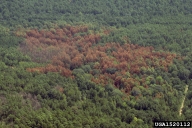
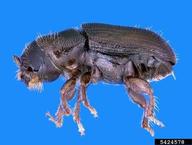
Order: Coleoptera
Family: Curculionidae
The southern pine beetle (SPB; Dendroctonus frontalis Zimmermann) is native to the southern and southeastern United States, and Central America from Mexico to Nicaragua. In recent years, SPB has expanded outside of its native range to include portions of the north-eastern United States, including New York and New Jersey (see comment below near range map); this can be attributed in part to climate change. As SPB continues to move north, it poses a threat to Canadian pine forests. However, to date, SPB has not been detected in Canada.
Physical Description
Eggs: Round to oval in shape, pearly white in colour, and are found in galleries located in the inner bark of pine trees.
Larvae: Crescent shaped, white wrinkled bodies with a caramel coloured head. Upon hatching, the larvae are about 2 mm long. Mature larvae are about 7 mm long.
Pupae: Same colour and size as the larvae.
Adult: Immature adults or “callow”, are yellowish-white in colour, but they soon turn dark brown as their cuticle hardens. The size of adults ranges between 2-4 mm.
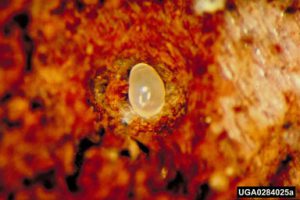  |  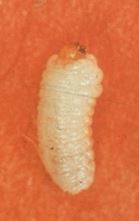 |  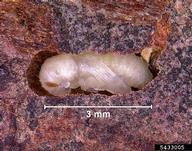 |
| Egg | Larva | Pupae |
Life Cycle
Female southern pine beetles select a host tree on which they drill into the inner phloem using their mouthparts, creating galleries where they are able to mate and lay their eggs. The eggs hatch 3-9 days after oviposition. The emerging, legless, new larvae feed on the inner bark and bore galleries perpendicular to the adult egg galleries, moving toward the outer bark where they pupate. The pupal stage lasts from 5-17 days. The callow (immature) adults stay right under the bark for 6-14 days until the cuticle hardens and becomes dark in colour. The adult beetles then bore their way outside of the bark, and fly to attack a new host tree.

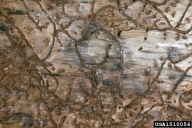
Photo: USDA Forest Service – Region 8 – Southern , USDA Forest Service, Bugwood.org
Southern pine beetle egg galleries.
All species of pine are potential hosts for SPB where it is established (Thatcher et al., 1980). However, SPB has been documented to have different preferred host pine tree species depending on where it is found.

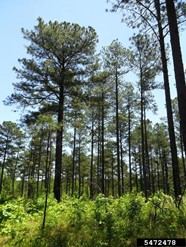
Photo: David Stephens, Bugwood.org
In southern United States, SPB preferred hosts are:
- Loblolly pine (Pinus taeda L.)
- Shortleaf pine (Pinus echinata Mill.)
- Pond pine (Pinus serotina Michx.)
- Virginia pine (Pinus virginiana Mill.)
- Pitch pine (Pinus rigida Mill.)
SPB can also attack the following species, which are found in Canada:
- Eastern white pine (Pinus strobus L.)
- Norway spruce (Picea abies L.)
- Austrian pine (Pinus nigra Arnold)
- Scots pine (Pinus sylvestris L.)
- Red pine (Pinus resinosa Ait.)

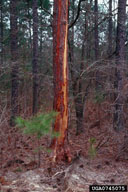
Photo: Erich G. Vallery, USDA Forest Service – SRS-4552, Bugwood.org
It is important to note that environmental stress factors such as drought, lightning strikes, and fire can increase the susceptibility of host trees to SPB infestations.
Signs of SPB infestation often first appear at the top of the tree and then move down.
There are three main stages for SPB attacks with distinctive signs – green crown, yellowish crown, and brown crown.
Stage 1: Green crown
- Adult SPB start boring into the living bark of their host
- Tree exudes fresh resin in response to the attack to pitch out the beetles
- Crown is still be green
- Resin later hardens on the outer bark forming what looks like a “popped popcorn”


Photo: USDA Forest Service – Region 8 – Southern ,USDA Forest Service, Bugwood.org
Hardened resin from a host tree infested with SPB.
Stage 2: Yellowing crown
- More beetles gather on the host tree
- Tree becomes weak and is no longer able to defend itself
- Foliage turns a yellow colour
Stage 3: Brown Crown
- Many exit holes will be seen on the bark
- Foliage is brown indicating the death of the host tree


Photo: Gerald J. Lenhard, Louisiana State University, Bugwood.org. Image showing signs of a SPB infestation at three different stages: green, yellow and brown crown.

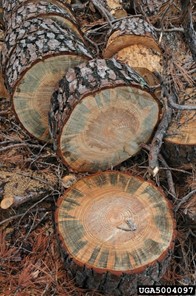
Photo: Ronald F. Billings, Texas A&M Forest Service, Bugwood.org. Blue staining fungus.
Blue-stain fungi (Ophiostoma minus) can be introduced to the sapwood of pine trees by the SPB, or other species of beetles or mites. The fungi cause the trees to become weaker and therefore, to die more quickly. The blue staining fungus is an ectosymbiont of the SPB, which means that it is often carried by the adult SPB as they attack new trees.
The blue staining fungus disrupts the interaction between the larvae and the nutritional fungi that are found in the wood fibre thereby, causing the larvae to die (Hofstetter et al., 2005). However, as the fungi weakens tree defenses, it may be an important determinant in tree susceptibility to SPB (Otrosina et al., 1997)
The southern pine beetle is native to southern and southeastern states in the United States, as well as Central America, from Mexico to Nicaragua. In the United States, it has been found in portions of Alabama, Arkansas, Delaware, Florida, Georgia, Kentucky, Louisiana, Maryland, Mississippi, Arizona, North Carolina, Oklahoma, South Carolina, Tennessee, Texas, Virginia, West Virginia, Pennsylvania, and New Mexico. In recent years, the SPB has managed to expand north beyond its natural range due to warmer winters. The new range of SPB currently includes both the states of New York and New Jersey.


Map: Clarke and Nowak, 2009
The areas highlighted in red indicate the areas in which SPB are found in both North and Central America.
Click here to view a map that shows the tracking of SPB invasions using detection traps into the northeastern forest of the U.S.
Economic impacts
Southern pine beetle outbreaks can cause significant economic impacts, especially with respect to the forest industry. The timber loss in the eastern United States, due to a SPB outbreak that occurred from 1999 to 2002 was estimated to result in an economic cost of $1 billion (Clarke and Nowak, 2009). In addition, impacts specific to the saw timber and pulp industry have been significant. A study showed that short term impacts of SPB outbreak caused an average loss of $43 million per year for the timber industry, but a $30 million gain per year for wood-using firms as a direct result of the temporary surplus of timber due to increased harvest (Pye et al., 2011). The long term impacts, however, greatly outweigh the short term benefits of these types of disruption.


Photo: Ronald F. Billings, Texas A&M Forest Service , Bugwood.org
An aerial view of the devastating effects of the spread of SPB.
Ecological impacts
SPB outbreaks influence the forest species composition and succession, negatively affecting the forest nutrient cycle and quality of soil due to nutrient leaching and increased erosion (Leuschner, 2006). The modifications in vegetation have implications on wildlife food resources and habitat. However, the impact on wildlife varies between positive, negative and zero net impact depending on the species and its ecological requirements (Leuschner, 2006). The gaps created in the forest pine canopy were found to be positive for the deer populations because of the increase in understory vegetation and grasses that are favoured by deer (Leuschner, 2006). However, the pine warbler has been found to be negatively impacted by the SPB as the infestation results in the destruction of the bird habitat (Tchakerian et al., 2015). The impact of the SPB on the red-cockaded woodpecker is a large concern in southern U.S. Although the impact of SPB on pine warbler and red-cockaded woodpecker are not pertinent to Canada, it is important to understand the potential impact that SPB could have on wildlife where it becomes established.

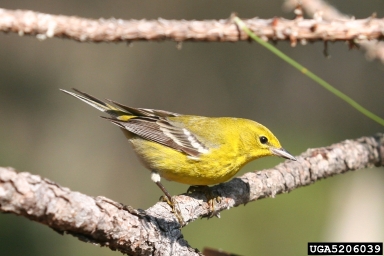
Photo: Johnny N. Dell, Bugwood.org
The southern pine beetle negatively affects the pine warbler, pictured above, by destroying the bird’s habitat.
Social impacts
In the United States, SPB outbreaks have had affected property values where pine trees and stands are located (Coulson and Meeker, n.d.). With the great loss of pine trees, SPB outbreaks have also impacted recreational use of pine forests and caused a decline in aesthetic value of pine dominated forests (Coulson and Meeker, n.d.).
Prevent
To reduce the chance of attack by the SPB it is important to maintain the health of susceptible forests. To mitigate potential impacts of SPB in susceptible areas, options include:
- Removal of poorly performing pine trees as they are more susceptible to bark beetle attacks (sanitary thinning)
- Promotion of a healthy forest by:
- Maintaining a diverse forest with a range of tree species, and planting less susceptible species where appropriate
- Adding slow-release fertilizers to improve the strength of pine trees on private property
- Moisturizing dry soil.
Respond and Control
Mechanical
Salvage removal of pine trees may be a cost-effective option for private landowners. When cutting or removing infested pine trees it is recommended to also cut a buffer strip of uninfected trees.
Cut and leave is a method to manage small areas of infested trees under warm temperature conditions. With this method, the infested trees, along with a band of uninfected trees in a designated buffer zone are cut and all are left where they fell. Warm temperatures play a vital role in the success of this practice wherein the sun exposure overheats the beetles in the fallen trees. This method is typically applied during times when SPB populations are propagating and has been extensively applied along the Gulf coast of the United States.
Pile and burn is an effective control practice where the bark of infested trees is burned to kill any existing SPB after the infested trees have fallen.
Biological
Research for biological control is ongoing to determine what natural enemies can be used to control SPB. The checkered beetle (Thanasimus dubius) which is native to North America is one of the most studied predators of the SPB. Research into this potential biological control agent is ongoing.

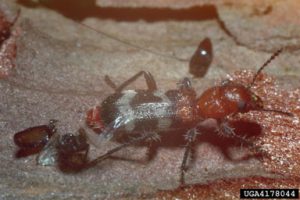
Photo: John Moser, USDA Forest Service, Bugwood.org
Checkered beetle after feeding on SPB.
Chemical
Chemical treatments are used to manage SPB infestations in urban forests and on trees located on private property in some areas of the United States. As chemical treatment can be expensive, it may only be a suitable option to consider for high-value trees. It is important to note that some chemical treatments can protect trees for a period of time from SPB attacks, but not from blue-stain fungi, which can be damaging to the tree on its own.
In the southern United States, SPB insecticides are used as an effective method of prevention on uninfested trees of high value in recreational and residential areas. The commonly used insecticides in the southern United States contain permethrin or bifenthrin as active ingredients – both of which are registered in Canada for use in insecticides. The systemic chemicals emamectin benzoate and fipronil have shown good efficacy for high value tree protection from SPB in the United States (Billings, n.d). However, both mentioned systemic chemicals are not registered in Canada for use in insecticides.
Example Integrated Pest Management Strategy
In many cases, management of SPB occurs as follows (USDA Forest Service):
- Frontalin-baited traps are set during the primary dispersal phase of SPB to help predict beetle activity for that year.
- Aerial surveys are conducted to detect potential SPB infestations, and locations are recorded on a GPS for mapping.
- Ground crews confirm the locations of infested trees, marking the extent of the infestation
- Treatments are assigned based on the data collected both aerially and confirmed on the ground level.the chance of attack by the SPB it is important to maintain the health of
Economic impacts of the southern pine beetle
(SPB). Although we anticipate that SPB outbreaks cause substantial economic losses to
households that consume the nonmarket economic services provided by healthy forests, we …
Southern pine beetle infestations in relation to forest stand conditions, previous thinning, and prescribed burning: Evaluation of the southern pine beetle prevention …
USDA Forest Service and Southern Group of State Foresters) has encouraged and provided
cost-share assistance for silvicultural treatments to reduce stand/forest susceptibility to the …
Threats to North American forests from southern pine beetle with warming winters
forest insects 1, 2, 3, 4, 5. Recent unprecedented expansion of the southern pine beetle
(SPB, Dendroctonus frontalis) into New Jersey, New York and Connecticut in concert with …
Further Reading
The Invasive Species Centre aims to connect stakeholders. The following information below link to resources that have been created by external organizations.

